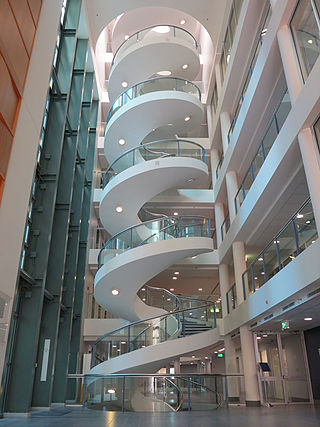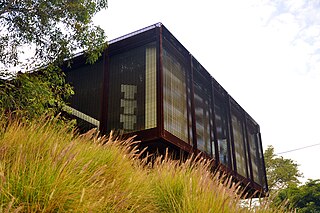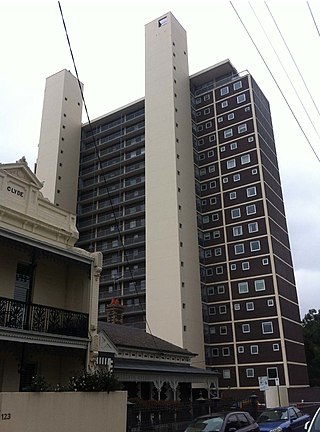Sean Godsell is an Australian architect.

Alexander Popov is an Australian architect working in the Late 20th Century Modern style.
The Gold Medal is the highest award of the Australian Institute of Architects, awarded annually since 1960. The award was created to recognise distinguished service by Australian architects who have:
The Robin Boyd Award for Residential Architecture is an Australian architectural prize presented by the Australian Institute of Architects since 1981.
Neil Clerehan was an Australian architect and architectural writer.
Kevin Borland was an Australian post-war Architect. Over his career his works evolved from an International Modernist stance into a Regionalist aesthetic for which he became most recognized. Many of his significant works were composed of raw materials and considered ‘Brutalist’ typifying Borland’s renowned motto ‘architecture is not for the faint-hearted’. Borland died in 2000 leaving a legacy of work throughout Victoria, New South Wales and Tasmania.

Kenneth Frank Charles Woolley, AM B Arch, Hon DSc Arch Sydney LFRAIA, FTSE, Architect, was an Australian architect. In a career spanning 60 years, he is best known for his contributions to project housing with Pettit and Sevitt, the Wilkinson Award-winning Woolley House in Mosman, and his longstanding partnership with Sydney Ancher and Bryce Mortlock. He is regarded as being a prominent figure in the development of the Sydney School movement and Australian vernacular building.
Philip Harmer is an Australian architect. He graduated from the University of Melbourne with a bachelor's degree in Architecture, and became a Fellow of the Royal Australian Institute of Architects (RAIA). Harmer has a strong appreciation for sculptural forms and spaces that are powerfully shaped or wrought; thus, his works display the cleverness of how certain materials and details are used to represent his individual persona.
Kerstin Thompson is an Australian architect, born in Melbourne in 1965. She is the principal of Kerstin Thompson Architects (KTA), a Melbourne-based architecture, landscape and urban design practice with projects in Australia and New Zealand. She is also Professor of Design at the School of Architecture at Victoria University of Wellington, New Zealand, and Adjunct Professor at RMIT University and Monash University.
Paul Morgan is a Melbourne–based architect whose work is prominent throughout Australia. Morgan is also an editor, lecturer, critic, and a writer.

Kew House is an architecturally notable house designed by Australian architect Sean Godsell as his own family home, built in 1996–1997 and located at 8 Hodgson Street in Kew, Victoria, Australia.

The Walsh Street House, also known as the Boyd House II, is a family home in Walsh Street, South Yarra, Victoria, Melbourne, Australia, designed by Robin Boyd in 1958, which the Boyds moved into a year later. Robin Boyd was known not only as an architect but also an architectural writer, educator and commentator. Born in 1919, as a member of the Boyd family, he came from a creative family background of sculptors, painters and architects. He and his wife Patricia occupied the South Yarra home with their two daughters.

The Nichols House is a residential building designed by the Australian architect Kevin Borland. The construction was completed in 1973 and awarded the OPCD Bronze Medal for The Age/RAIA House of the Year together with Max May’s Rattle House at Harkaway in 1974. The project is a medium density development which shows many of Borland's architectural ideals regarding the configurations of how the modern family dwells in. These ideologies resulted in two major themes, a distinctive connection with the topography of the site and a creative approach to the ideas of family events happening in stages such as a theatre.

Domain Park Flats is a 20-storey residential building in Melbourne, Australia, completed in 1962. The block was designed by influential architect Robin Boyd CBE, one of the foremost proponents for the International Modern Movement in Australian architecture and recipient of the RAIA Gold Medal in 1969.
Arthur Baldwinson (1908–1969) was one of Australia's first generation of prominent modernist architects to experience the European modernist movement first hand. His modernist contemporaries include Roy Grounds and Frederick Romberg in Victoria, as well as Sydney Ancher and Walter Bunning in New South Wales; their respective Australian architectural careers in modernism began in the late 1930s. Baldwinson's active professional career as an active practising architect was relatively short (1938–1960).

Louise St John Kennedy has been an Australian architect based in Perth, Western Australia, and has practiced across Australia and America. Louise has a degree in Psychology from the University of Western Australia (1970), and a Bachelor of Architecture from the University of Melbourne (1978). She continues to practice in Claremont, Western Australia, now as a Building Designer, Interior Designer and Landscape Designer.
Donovan Hill was a Brisbane, Australia, based architecture firm that was founded by Brian Donovan, Timothy Hill in 1992. The firm worked extensively in Brisbane, growing from a workforce of four to 50 within their 17-year existence. Donovan Hill's designs emphasized environmental impact and life cycle. The majority of their commissions were commercial, institutional and civic buildings, and included design concepts relating to interior fit out, landscape and master planning.
Lyons House is a heritage-listed private residence at 733 Port Hacking Road, Dolans Bay, Sutherland Shire, New South Wales, Australia. It was designed by Robin Boyd; Marion Hall Best designed the window coverings; and Bruce Mackenzie designed the landscape.
Marcus Martin (1893–1981) was an Australian architect. He was an associate of the Royal Institute of British Architects, fellow of Royal Institute of Architects, and honorary secretary to the Royal Victorian Institute of Architects.

Gabriel Poole (1934–2020) was an internationally recognized, award-winning Australian architect, known for innovative, lightweight designs that are site and climate responsive. His ‘Tent House’ in Eumundi won the Royal Australian Institute of Architects (RAIA) Queensland Innovation Award, the Robin Dods Award and the RAIA National Robin Boyd Award in 1991. In 1998 Poole was awarded the nation's highest architectural award, RAIA Gold Medal, for his lifetime contribution to Australian architecture. He was also an advocate of housing affordability, pioneering low-cost, pre-fabricated designs.









